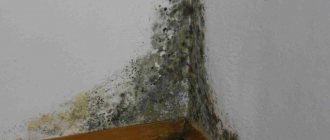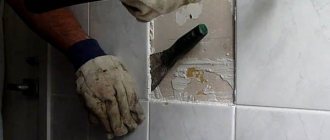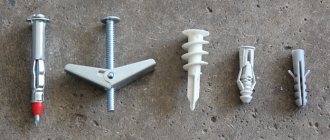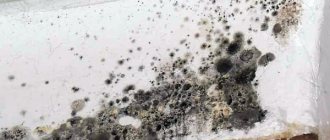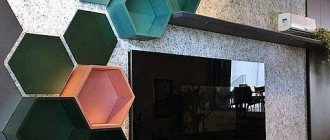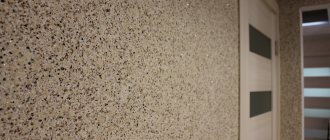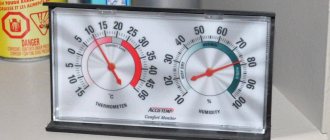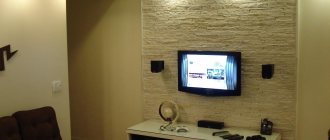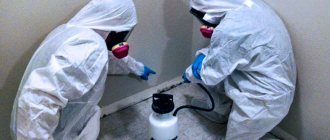Dampness on the walls is a common problem that can appear not only in an apartment, but also in a private house. It must be addressed immediately, because when the walls and corners become damp, not only the wallpaper begins to darken and peel off, but also mold appears.
Dampness on the walls can contribute to the emergence of various diseases, and become a gathering place for insects, mites and other fungi . If the wall in your apartment becomes damp, what should you do and where should you go?
Damp wall
Dampness on the walls can appear for several reasons. The main indicator of dampness in a wall is mold. A damp wall is formed from three main reasons:
- External leaks
- Poor thermal insulation
- Lack of ventilation
Dampness on the walls creates a favorable environment for the growth of mold and creates an unfavorable environment for human habitation. The main negative factors of damp walls in a room are:
- Heat leakage and increased energy consumption for heating a room with damp walls.
- Active reproduction of fungal and mold spores.
- Decreased immunity and exacerbation of chronic diseases of the human body due to uncomfortable temperature and humidity conditions in the room and the active reproduction of fungal and mold spores.
Our specialist will help you correctly determine the cause and give further recommendations - how to remove dampness from the walls and how to treat the walls against dampness. Determining on your own the reasons why your wall is damp, without the appropriate equipment, can lead you down the wrong path of further action. Savings on diagnostics will definitely affect your wallet, since any construction work to eliminate dampness in our time is not very cheap.
Protecting walls from dampness
Let's look at the three main places where the problem of dampness on walls is most often encountered:
- Damp wall in the apartment.
- Damp wall in the house
- Damp wall in the basement
Damp wall in the apartment.
As mentioned earlier, a damp wall in an apartment can be caused by three main reasons: external leaks, poor thermal insulation and lack of ventilation.
. If you already know what your main reason is for dampness on the walls, then we can recommend you materials to protect walls from dampness.
External leaks can occur:
- due to careless neighbors located on the floor above, who can flood you
- due to poor waterproofing of the external surface of the wall facing the street
- due to poor sealing of interpanel seams and joints.
If you are flooded by neighbors on the floor above or you live on the top floor with a faulty roof, then first of all you should make sure that these leaks are stopped. Once the leaks from above have been stopped, you will inevitably face the problem of drying the ceiling and walls. It all depends on how much water your ceilings and walls are saturated with water. For reference:
1 cu. m of brick wall can hold up to 400 liters of water. It sometimes takes several years for a wall that gets wet to dry naturally.
For what reasons does the wall get wet?
The first step is to determine the source of moisture, and there can be a number of problems:
- The outer wall is freezing. In old buildings this is the most common problem; this is due to the fact that previously they could only dream of high-quality thermal insulation. The main signs of this are constant cold in the room and increased levels of humidity, while the walls are quite cold.
And in order to solve the problem, you can heat the room better in the cold season, but this will lead to additional costs. Or you can insulate the wall of the house from the outside. It is not advisable to insulate the wall inside the house; this will not solve the problem.
- Insufficient waterproofing. This option most often applies to those who live on the first or last floor. If the wall at the bottom gets wet, then the moisture most likely penetrates from the street. Signs of insufficient waterproofing are large stains that form during periods of increased dampness, usually in the fall.
To solve the problem, you need to find the places where the moisture is coming from and eliminate the problem.
- Poor ventilation system. This is a common phenomenon at the moment, often the corners of the room do not receive ventilation, and therefore they sweat.
To solve the problem, create optimal circulation of fresh air in the house, that is, carefully consider the ventilation system.
Source
The floor and wall in a private house are damp
In this case, repairs are useless, since all your attempts will be actively destroyed by the mold that has arisen in the walls.
In what ways can you speed up the drying of walls and ceilings after localizing external leaks?
Washed laundry always dries faster where there is active ventilation and less air humidity. The same principle applies to dampness in the walls. In rooms with damp walls after external leaks, it is necessary to create a mode of active ventilation and lower air humidity. How to create such a mode? In summer, when the weather is hot, it is enough to keep the windows constantly open, creating a draft in the rooms. In all other cases, such a regime will have to be created artificially, using special air dryers.
How long will it take to dry damp walls like this?
It all depends on several factors: what material the walls are made of, how thick they are, and how wet they are. To speed up the drying process of damp walls after localizing external leaks, it is necessary to remove wet wallpaper and old plaster from the walls, which will create an active obstacle to the ventilation of the wall surface.
Is it possible to further intensify the drying of walls and speed up repairs after localizing external leaks?
Yes you can. On the market of modern building materials, there are environmentally friendly capillary active sanitizing heat-insulating plasters of the THERMO series, which perform very important necessary functions - they constantly artificially draw moisture from the walls, drying them and preventing the possibility of the formation of fungus and mold. In addition to the properties described above, the thermal insulating sanitizing plasters of the THERMO series additionally have the following properties: durable, non-flammable, moisture-resistant, inert in aggressive environments, have excellent sound absorption that prevents the occurrence of echoes, as well as high vapor permeability and adhesion to all building materials, including glass In short, by using the sanitizing heat-insulating plaster of the THERMO series in repair work at the stage of incomplete drying of the wall, you do not risk ruining your repair, since thanks to its unique hydrophobic and air-permeable properties, Thermo plaster helps remove moisture from the building structure.
Dampness in the walls of the apartment communicating with the street.
If one wall or several walls of your apartment face the street and these walls are constantly wet, then two reasons for dampness in the walls can be considered - either poor waterproofing of the outer surface of the wall, or insufficient thermal insulation of the wall.
In the first case, to restore the waterproofing of the outer surface of the wall communicating with the street, it is necessary to use special water repellents
.
which create a protective water-repellent coating on the wall surface. The water repellent
is inexpensive, and it is quite simple to apply by spraying it on the wall. The main problem can only arise in the performer of the work, since in most cases such work must be performed at high altitudes.
In the second case, to insulate the wall, it is necessary to decide on which side the wall will be insulated from the outside or from the inside? For external wall insulation, it is necessary to resort to the help of third-party organizations specializing in high-altitude work. This solution to the problem is often unacceptable, since no one wants to pay for expensive work. However, if you still decide to externally insulate the apartment wall, we recommend that you use either Teplomet-Facade
.
or heat-insulating sanitizing plasters of the THERMO series.
Teplomet liquid-ceramic thermal insulation
.
or heat-insulating sanitizing plaster of the THERMO
.
What is the difference between Teplomet and THERMO?
Liquid-ceramic thermal insulation Teplomet
It is most convenient to apply when the wall is in its driest state.
This usually happens in the summer. Teplomet
liquid thermal insulation is extremely simple and you can handle this work yourself.
You can
more about the properties of Teplomet here...
As for the thermal insulating sanitizing plaster of the THERMO series,
then you can’t do without it if your wall is in a damp state at the time of starting work on insulation from the inside of the apartment.
Thanks to its unique hydrophobic and breathable properties, Thermo
helps remove moisture from damp walls while insulating them.
However, the technology for applying thermal insulating sanitizing plaster of the THERMO
is more complex than the liquid thermal insulation technology
Teplomet
.
And here you will have to resort to the help of a qualified specialist, which will certainly affect the cost of work on insulating the wall from inside the apartment. more about the properties of THERMO
and the technology of its application
here...
Reasons why apartment walls become damp
Before you begin to solve the problem, you should answer the question why the walls in the apartment get wet and at what stage the damage is. If the degree of moisture in the wall is very high, then you will need to make a radical decision and, without delay, correct the situation as quickly as possible.
The first sign that indicates that the walls in the apartment are getting wet is that its surface becomes damp, the wallpaper begins to peel off and the plaster crumbles, and at the final stage the wall is covered with a layer of black mold. If such a phenomenon occurs, then it is extremely important to first determine why the walls in the apartment are damp. In the future, this will allow you to choose the right method to correct the situation, including the necessary devices and materials that will be used. The main reasons why the walls in an apartment become very wet are the following:
- Insufficient wall insulation or low waterproofing often leads to the walls of the apartment getting wet. As a rule, this is observed in old houses and in apartments located on the highest or lowest floors. It should be noted that wet walls in an apartment on the top or first floor appear in the autumn-spring period, and not in winter, as in other cases.
- There is high humidity in the room or location of the home. If we are talking about a brick building, then a large amount of moisture rises from the basement, resulting in a wet and unsightly wall in the apartment.
- Insufficient ventilation can also be the reason why the walls in the apartment become damp. For the same reason, indoor windows fog up.
- Quite often the wall in a corner apartment becomes damp, and many owners worry about what to do in such a situation. This is due precisely to the inconvenient location of the living space and the fact that the walls of such a home are exposed to negative factors much more than in other apartments.
- The premises have recently been renovated. This reason, which explains why the walls in the apartment become damp, is the only one in which such a consequence is considered natural. As a rule, during repairs a large number of materials are used that contain water and after the necessary work is completed, moisture remains in the walls, especially if the room is poorly ventilated. In such a situation, you shouldn’t worry and worry about what to do when the walls in your apartment get wet, but it’s better to wait a little time and the moisture will dry out on its own.
How to get rid of dampness depending on the cause
After determining the reasons why the walls in the house become damp, you can determine ways to eliminate dampness on the walls of the house and begin to eliminate the shortcomings. Sometimes you can do this yourself, but more often you have to turn to specialists, especially if it involves working at heights and roof repairs.
Freezing of walls and insufficient heating. Insulation of the room should be done from the outside, inviting industrial climbers for this. Insulation from the inside will almost certainly lead to a shift of the “dew point” to the middle of the building structure. As a result, the flow of moisture through the wall can only increase.
The specialists you contact for help will be able to perform the necessary thermal calculations and determine the thickness of the thermal insulation layer and the efficiency of the batteries. If the heating system operates unsatisfactorily, it can be recommended to increase the heat transfer area of the heating devices without abandoning the external insulation of the walls.
Ineffective ventilation. The absence of a hood with new sealed windows can lead to condensation and moisture settling in the walls. In this case, it is recommended to ventilate the room through slightly open windows. Another effective way would be to install a low-noise fan in one of the exhaust ducts. Electricity consumption in this case will be minimal, and the effect will be noticeable.
Roof leak. If you live on the top floor, start looking for moisture ingress by inspecting the attic or flat roof. A roof leak is often the cause of dampness in an apartment. It is clear that in this case only urgent roof repairs can help. And if you can’t do it yourself, then you shouldn’t save. Call a roofer.
Poor quality waterproofing of the foundation. This reason is found in private houses. The deficiency can only be corrected from inside the basement by introducing injection waterproofing materials. If there is no full basement in the house, you will have to dig out the foundation and use coating or rolled materials.
What to do if the wall in your apartment gets wet?
Having figured out why the wall in the apartment gets wet, we found out that there can be several reasons for the occurrence and development of such a situation. Accordingly, to answer the question of what to do if the wall in the apartment is damp, it is possible only if the cause of the problem is precisely determined.
For example, if a wall in a renovated apartment becomes damp, no special manipulations will be required. It is enough to ventilate the apartment well and keep the windows open for a while. If repair work is carried out in winter, it is worth providing heat in the apartment so that the moisture remaining after the repair evaporates. If the heating is good, then batteries are sufficient for this purpose, but if they cannot cope, then you will need to turn on the heater.
If there are problems with ventilation, if the wall in the apartment is damp, only an experienced professional will tell you what to do, although at the initial stage you can cope with a difficult situation on your own. It is enough to remove objects that interfere with quality air ventilation. For example, if moisture accumulates in a small area behind the curtains, then it is quite possible to raise or remove the curtain altogether and move the furniture away. In this case, if the wall in the apartment gets wet, such actions can quickly deal with the problem. In general, the problem of what to do when the walls in an apartment become damp in the absence of good ventilation can be solved comprehensively. You will need to check all the ventilation openings that are located inside the apartment and ventilate the room more often. Additionally, it is worth installing a hood in the kitchen to remove excess moisture.
As we have already noted, the reason why a wall in an apartment gets wet may be the lack of high-quality waterproofing. This problem is more serious and difficult to cope with. There can only be one solution here - to sufficiently insulate the wall surface. As a rule, if the walls of an apartment become wet, it means that the seams on the outside of the building have become unusable. What to do when the walls in your apartment get wet? in this case, only a specialist can advise. This will require serious intervention, since ordinary ventilation cannot solve the problem.
What to do if wet walls appear in your apartment in winter? This question concerns many home owners who are faced with such a problem. Moreover, if you take independent action in this case, you can only worsen the situation. Many people do not have the opportunity to perform additional insulation on the outside of the building and, by laying insulation from the inside, they only worsen the situation by shifting the dew point. As a result, a wet wall in an apartment will become even wetter in winter, and later moisture will begin to accumulate under the insulation into a puddle. It is extremely important to understand here that even if the owner of the apartment is an experienced climber and builder, you should not carry out the insulation work yourself, but it is best to trust experienced craftsmen who will do all the work to the highest possible quality.
What is condensate
Dampness in an apartment or house often provokes a phenomenon called condensation. In simple terms, where waterlogged air and a cooled surface “meet”, water droplets form.
You've probably noticed that glass on windows or loggias, heating radiators or pipes periodically “cry” - this is condensation dripping. The reasons for the appearance of moisture can be different: improper installation of double-glazed windows, insufficient air circulation, presence of sources of moisture, poor ventilation.
How is thermal insulation carried out in rooms where the wall is damp?
To answer the question of what to do when the walls in the apartment get wet, we can suggest strengthening the existing thermal insulation. This will eliminate the penetration of moisture and cold from the outside and will give the greatest effect. It is important that insulation is carried out both outside and inside.
Unfortunately, it is almost impossible to carry out such work on your own. This option is suitable for free-standing buildings, first floors, as well as buildings where there is no need to climb to a significant height to complete the finishing.
It is extremely important to choose the right thermal insulation materials, which are presented in large quantities on the construction market. To carry out the work, it is best to choose trusted manufacturers who pay attention to the high quality characteristics of materials. It is important to remember here that even if wet walls appear in the apartment on the top floor, then it is worth insulating the area from the outside, and not from the inside.
If we are talking about an apartment building, then insulating the walls in this case is almost impossible, so you will have to limit yourself to the interior decoration of the walls, which, if the work is carried out correctly, will give a guaranteed high-quality result. In this case, it is worth paying attention to two important parameters:
- when a wall in an apartment gets wet, you must first determine the water absorption coefficient of the material used. The speed and degree of moisture removal from the apartment depends on this indicator. The lower the indicator, the better the water-repellent properties of the material. This will make it possible to eliminate such problems as a wet wall in an apartment in winter;
- To determine what to do when the walls of the apartment get wet, it is worth insulating the walls, but at the same time taking into account the thickness of the layer purchased for finishing the material. Here it is important to make such a density that there will be a sufficient thermal conductivity coefficient. If the coefficient is small, then the layer will need to be made thin.
Only by taking into account all these points can you achieve a significant reduction in humidity in the apartment and return the wall to its original appearance. To answer the question why there are wet walls in the apartment and what to do if the wall in the apartment gets wet, it is enough to study the theoretical aspects of this issue and contact a specialist for practical advice.
How to insulate the foundation if the wall in the apartment is damp?
What to do if the walls in the apartment are wet in winter and the apartment is located on the first floor of the house? In fact, the problem here can be solved quite easily. You only need to insulate the foundation. This action is especially relevant for those who are interested in giving their home increased sound insulation. This will not only solve the problem of a wet wall indoors in the apartment in winter, but will also get rid of noise and unpleasant sounds.
Here it is worth giving preference to materials that have a high noise absorption coefficient, since this will save time on repairs and installation of sound insulation. The flammability class of materials is extremely important to eliminate the possibility of sudden fire. The best option may be a material of class G1, since the thermal insulation, even during combustion, does not provoke the appearance of a source of open flame. It is worth highlighting several of the most common insulation and at the same time soundproofing materials. The list of the most famous includes the following:
- Mineral wool is a very common material that has low cost and excellent technical characteristics. When the walls in an apartment get wet, an experienced craftsman can advise you on what to do and most likely, he will say that, despite good performance indicators, mineral wool for insulation is not the best choice. The thing is that the material has a high coefficient of water absorption;
- polystyrene foam is an excellent choice if you don’t know what to do if a wall in your apartment gets wet. The material is suitable for interior and exterior decoration, and it practically does not absorb moisture. The disadvantage is the low steam transmission ability. This does not allow air to circulate freely. In addition, when ignited, the foam begins to release toxins;
- “warm” plaster, which is used to insulate walls from the inside and outside. The use of such material is especially relevant if wet walls appear in the apartment on the top floor. This is due to the fact that the material is not a traditional insulation and does not absorb moisture. In addition, this plaster has excellent sound insulation properties. The disadvantage is that the coating is too heavy. The material is not suitable for private houses, as it requires a reinforced foundation;
- Cork insulation is used for interior decoration. If you have no idea what to do when the wall in your apartment gets wet, then you should pay attention to this material, which has low thermal conductivity, but is also lightweight. The disadvantage of the coating is considered to be increased flammability.
Surface insulation scheme if the wall in the apartment gets wet
Many apartment owners are interested in the question of where to go if there is a wet wall in the apartment and what to do in such cases. In fact, there can be only one solution - to visit a construction company that provides similar services. This will immediately provide several advantages. On the one hand, you will decide what to do when the wall in the apartment gets wet, and on the other hand, you will receive high-quality work that will not require rework in the future. Another important point is that the master has an idea of what to do if there is a wet wall in the apartment, which means he will carry out all the necessary work strictly according to technology. For example, we can give the following algorithm for finishing a section of a wall.
For such work, craftsmen recommend using foam plastic or “warm” plaster. All work on wall insulation is carried out using the following algorithm:
- The work site is prepared, namely, it is cleared of dust and debris, after which leveling plaster and primer are applied to it. The base for further work is ready and now you will need to glue the foam onto it, and then secure it with special dowels.
- Each sheet must be treated with an adhesive composition, and then pressed onto the prepared surface and pressed well. It is best to place the sheets in a checkerboard pattern, thereby increasing the strength of the structure.
- Fastening with dowels is carried out around the perimeter, and holes will have to be drilled in the material.
- After gluing and fixing the sheets, the finished finish is covered with reinforcing mesh and the overall structure is plastered. The walls are decorated with paint, and a layer of decorative plaster is applied to it.
Insulation of walls from the inside if the wall in the apartment is damp
This option remains the only one when the homeowner does not know what to do when the wall in the corner apartment becomes very damp and where to turn if there is a wet wall in the apartment. In fact, if it is not possible to insulate the structure from the outside, then it is important to consider the procedure for insulating the walls from the inside. Experts recommend using any of the above materials in this case, however, you should choose insulation taking into account the individual dimensions of the walls, as well as the financial capabilities of the room owners. From this point of view, it is still not worth using polystyrene foam, since it can easily ignite and thereby threaten the lives of residents.
The entire insulation process takes place in several stages. Each stage is extremely important for the overall result, since it allows the finishing to be completed with the highest possible quality and with the expectation of long-term use in the future. The algorithm of actions in this case is as follows:
- The walls should be pre-prepared by cleaning them from dirt and old wallpaper.
- Impregnate the surface with a primer.
- Assemble a frame from a metal profile or wooden blocks. The fastening pitch should be 40–60 cm.
- The insulation is placed in cells; if necessary, the sheets can be cut.
- Subsequently, the covering is covered with plasterboard and finished with plaster.
At this point, the interior decoration can be considered complete, and the room is ready for further use.
External moisture
The cause of dampness can be external moisture falling on the walls and penetrating through microcracks or poorly sealed seams inside. More often, such a nuisance is typical for apartments on the upper floors with a poor-quality drainage system, for walls along which drainpipes run, as well as panel houses with poorly sealed joints between the slabs.
moisture in corners
In order to eliminate the problem, it is necessary to clean the wall of the old coating, re-plaster it from the outside, prime it, cover it with waterproofing mastic, and only then completely paint the resulting surface. You can independently carry out such a cycle of operations either in a private house or on the first floor of an apartment building. In other cases, solving the problem of damp walls on your own will be very problematic due to the need to carry out high-altitude work. Therefore, you will have to turn to professionals.
Preventing the appearance of dampness
Following certain rules will help reduce dampness to a minimum and prevent its occurrence in the future.
- Laundry should be dried outside living rooms or with the hood turned on for air removal.
- When cooking, pots and pans should be covered with lids to prevent steam from escaping.
- In the bathroom, where the highest concentration of humidity is, as well as in the kitchen, hoods and ventilation openings should be regularly cleaned to remove excess debris, and these rooms should also be ventilated daily.
- In a private house, you can insulate the attic and also cover the walls with a waterproofing material, preferably with pores.
- All flammable substances that form a lot of moisture, in particular paraffin, should be used extremely rarely indoors.
- All rooms in the house should be ventilated daily.
- Correct errors in the heating system in a timely manner.
- Use a dehumidifier to reduce humidity. This household appliance can easily cope with the problem of dampness, and its compactness allows you to move the dehumidifier from room to room.
Excessive indoor humidity
The simplest reason, in terms of elimination, is high humidity in the apartment. It is possible that the appearance of pockets of dampness was preceded by the replacement of windows in the room. New windows closed the openings more hermetically and worsened the ventilation of the room. In some cases, in order to avoid dampening the walls of the apartment, it is enough just to ventilate the room more often.
If this is not enough, or the problem occurs in a room with potentially high humidity, for example, a kitchen, then you can try to improve the quality of ventilation. To do this, you can put a fan on the vent. Thus, ventilation will turn from natural into forced supply and exhaust with greater productivity.
Standard
The normal humidity level in an apartment or residential building is considered to be from 40 to 60% (depending on the purpose of the room), the optimal value is 45%. In winter, the air dries out, so the percentages “drop” slightly. You can measure the humidity level yourself using a special device - a hygrometer.
Such troubles cannot be left to chance. Both excessively humidified air and mold, which thrives on damp surfaces, can very quickly ruin property. In addition, fungal spores in the company of dampness negatively affect the health of home residents: they cause coughing, shortness of breath, aggravate respiratory tract diseases, and allergies.
